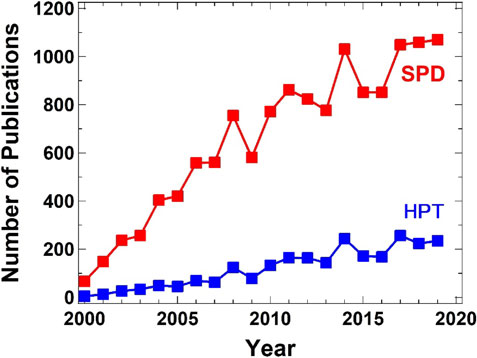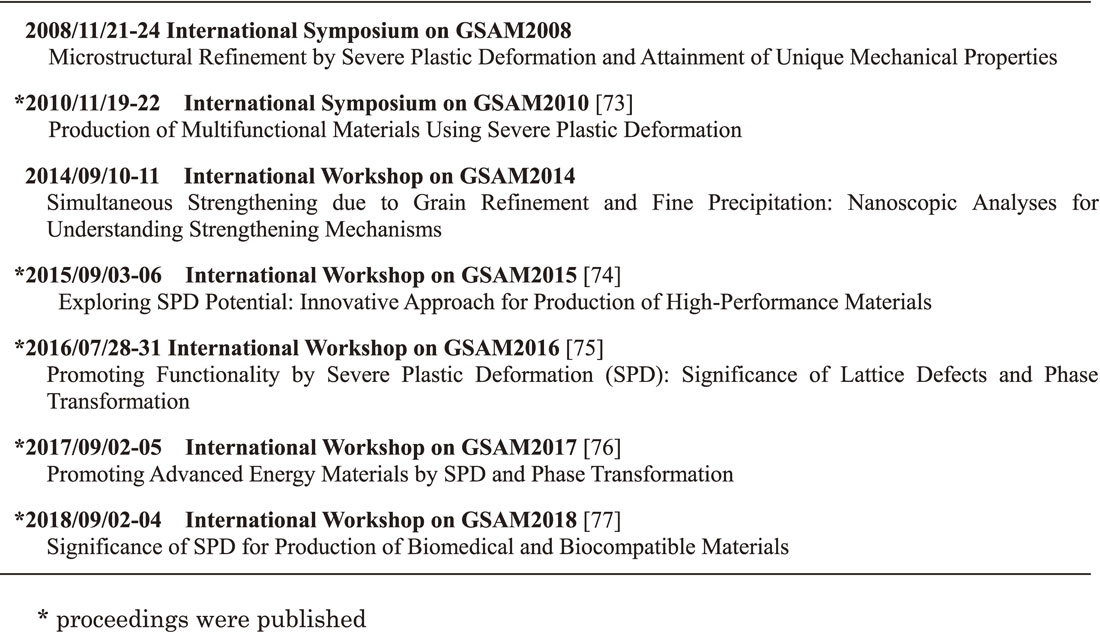2020 Volume 61 Issue 11 Pages 2241-2247
2020 Volume 61 Issue 11 Pages 2241-2247
This paper presents a current research trend for micro- and nano-structure controls using severe plastic deformation (SPD). The survey is carried out based on the special issue published in July and August, 2019, in Materials Transactions (Vol. 60, Nos. 7 and 8). The SPD-related research is rapidly growing particularly after the year 2000. The research ranges over processing, modeling, simulation, synthesis, characterization and evaluation. Among the various topics, a brief introduction is given for innovative approaches which will further promote the development of the SPD-related research.

Fig. 1 Numbers of papers published on SPD-related research and HPT-related research after year 2000. (Data were used from Scopus on April 23, 2020).
The process of severe plastic deformation (SPD) is gaining much attention as a powerful tool to control micro- and nano-structures. It thus produces enhanced mechanical and functional properties in a wide range of materials including metals and alloys, intermetallics, ceramics, oxides, semiconductors and polymers. This paper presents current research dealing with SPD processes.
Although many review and overview papers including books are available for the research using SPD processes,1–24) a special issue was edited in July and August, 2019, in Materials Transactions (Vol. 60, Nos. 7 and 8) under the title of “Severe Plastic Deformation for Nanomaterials with Advanced Functionality”.25) This special issue contains a total of 41 articles including mostly review and overview articles with a few additional regular articles. It covers SPD-related studies based on process developments,26–28) evaluations of structural properties26,29–35) and of functional properties,36–45) modeling and simulation,46,47) materials synthesis,32,48,49) roles of lattice defects,35,50–53) grain refinement and microstructural evolution,36,54–57) pressure- and/or strain-induced phase transformation,47–49,58,59) applications to polymers60) and metallic and non-metallic glasses,61) surface and microstructural modifications by SPD,29,62–65) and historical studies of SPD.66)
Before this special issue appeared, six SPD-related special issues were published from Materials Transactions: for the first three issues, under the titles of Severe Plastic Deformation for Production of Ultrafine Structures and Unusual Mechanical Properties: with subheadings of Investigating Role of High-Density Lattice Defects in 2008,67) Understanding Mechanisms in 200968) and Aiming Breakthrough in Materials Development in 201069) and, for the rest of the three issues, under the titles of Advanced Materials Science in Bulk Nanostructured Metals in 2012, 2013 and 2016.70–72) In addition, the latest version of the SPD special issue was planned based on the SPD-related workshops and symposiums held under the title of International Symposium/Workshop on Giant Straining Process for Advanced Materials (GSAM). Many authors of the special issues attended one or more of the workshops/symposiums. Proceeding books were published in 2010, 2015, 2016, 2017 and 2018 with subheading as documented in Table 1.73–77)

The research dealing with the SPD processes becomes popular as shown in Fig. 1 where changes of the number of SPD-related papers published are plotted. The papers were counted from those published in peer-review journals including proceedings papers screened by reviewing processes. The plots were started from the year of 2000 where the publications were very limited. Now, the related papers are published for more than 1000 in a year. Here, the SPD process includes equal-channel angular pressing (ECAP),78) accumulative roll bonding (ARB),79) high-pressure torsion (HPT),80) multidirectional forging (MDF)81) and others as defined in a review paper.2) The change in the published paper number for the HPT process is also plotted in Fig. 1 as this process is more versatile than others because the sample is well constrained under the pressure.

Numbers of papers published on SPD-related research and HPT-related research after year 2000. (Data were used from Scopus on April 23, 2020).
Nevertheless, the HPT process involves a couple of drawbacks to be overcome: one is an inhomogeneous development of microstructure as strain is more introduced with increasing from the center of disk sample and another is that the sample size is small. Recent approaches regarding how to cope with such drawbacks were overviewed in the latest issue of Materials Transactions.82) The inhomogeneity may be improved by employing ring samples instead of disk samples.66,83) Upscaling the sample dimensions may be achieved more easily by using the process of high-pressure sliding (HPS)84,85) than the HPT process. In particular, the SPD-processed region is enlarged by the combination with incremental techniques.86–91) Continuous process is also promising as demonstrated in several papers.28,92–98)
Among recent applications of the SPD processes under high pressure, the most innovative reports are the materials synthesis and the utilization of phase transformation occurring under high pressure and/or intense straining. Such applications create unexpected structural and functional properties. For the phase transformations, one of the most interesting reports is the formation of hexagonal diamond and cubic diamond from graphite by HPT processing at room temperature under pressures of 0.4 GPa and 0.7 GPa in good agreement with the predications of quantum mechanics as shown in Fig. 2.99) This finding is particularly of significance because graphite-to-diamond transformations occur thermodynamically above 2 GPa and practically under much higher temperature/pressure because of kinetic barriers. Theoretical modeling explains that drastic reduction in phase transformation pressure arises from strong stress tensor concentration at strain-induced lattice defects.47) Not only decrease in transition pressure, but also decrease in transition temperature can be achieved by SPD processing.58) It was shown that due to large fraction of lattice defects, even if the SPD is conducted at temperature, the transition temperature is equivalent to the heat treatment at an elevated temperature, which is defined as effective temperature.100,101)

Low-pressure graphite to diamond phase transformation by HPT processing, achieved experimentally at 0.4–0.7 GPa and predicted by quantum mechanics.99)
SPD processes which induce shear strain alter microstructures and crystal structures more significantly and are used to synthesize new phases.32,49) One of the most interesting trends is the synthesis of numerous new phases by application of ultra-SPD (i.e. shear strains over 1,000 or HPT turns up to 1000 or even higher).48,102) For example, the concept of ultra-SPD was used successfully to synthesize a new BCC Mg-based alloy for room temperature hydrogen storage as shown in Fig. 3, while Mg-based hydrogen storage materials function only at temperatures over 473 K.103) The method was also used to synthesizes the first high-entropy photocatalyst TiZrHfNbTaO11 for photocatalytic hydrogen production under UV light.104) Formation of FeNi with the L10 structure and interesting magnetic properties within 100 minutes is another promising finding by ultra-SPD, while this phase with interesting magnetic properties forms only within the astronomical time scales in meteorites.105) Formation of supersaturated bcc, fcc and hcp phases in the Mg–Zr system is another example on the potential of ultra-SPD, while Mg and Zr are thermodynamically immiscible even in the liquid form.106) It should be noted that ultra-SPD studies suggest that new deformation stages may present after stage V, although detailed compositional studies are required to confirm that these new stages are not due to contamination from HPT anvils.107)

Formation of Mg4NiPd with BCC structure and reversible hydrogen storage performance at room temperature after ultra-SPD with 1500 HPT turns.103)
There has been significant progress in recent years on the structural properties of severely-deformed materials such as hardness,34) strength/ductility30) and creep35) as well as on the functional properties such as superconductivity,40,41) thermoelectric performance,45) radiation resistance,44) photocatalytic activity,37) hydrogen storage,42,43) corrosion resistance38) and biocompatibility.39) Among all these properties, the biocompatibility appears to be the most attractive functional properties for commercialization of SPD process.71,108) For the structural properties, the achievement of room-temperature superplasticity in magnesium and aluminum alloys for the first time is one the most innovative results reported recently.109,110) Room-temperature superplasticity was realized by not only SPD-induced grain refinement but also by engineering the grain boundaries and introducing segregation to enhance grain boundary mobility, as shown in Fig. 4 for an Al–Zn alloy.110) Since the new age of NanoSPD was started with a study on low-temperature superplasticity in an HPT-processed Al-based alloy,111) achievement of room-temperature superplasticity is considered as another milestone in the NanoSPD field.

Achieving room-temperature superplasticity in ultrafine-grained aluminum alloy by segregation of Zn atoms in grain boundaries after HPT processing.110)
Although metals and alloys are still the most popular materials in SPD studies, there are new trends to apply the SPD methods to polymers,60) glasses,61) carbon polymorphs,59) semiconductors,36) ceramics47) and oxides.37) It should be noted that American physicist Bridgman processed many of these non-metallic materials by HPT in 1930s,80) but surprisingly SPD processing of these materials was overlooked by materials scientists for many decades. One of the most recent results were reported for polymers, in which SPD processing results in enhanced mechanical properties similar to metallic materials (see mechanical properties of a few polymers processed by twist extrusion in Table 2).60)

Oxides are another group of materials that show interesting structural features, microstructural features and functional properties after HPT processing.19,37) Although HPT processing of oxides have been of interest in geology and physics for many decades,80) the process was not received attention by materials scientists and NanoSPD community until recent years. In 2010, the authors of current article started the application of HPT method to oxides and recognized that real plastic deformation and lattice defects can be induced in oxides by HPT processing at room temperature.112) As summarized in Table 3, within past 10 years, the HPT method has been applied to various oxides such as α-Al2O3,112) γ-Al2O3,113,114) MgO,115) ZrO2,116,117) TiO2,118–120) nano-TiO2,121,122) ZnO,123) VO2,124) SiO2 glass,124) SiO2 quartz,125) Y2O3,126) Bi2O3,127) BaTiO3,128) LiTaO3,129) CsTaO3129) TiO2–ZnO130) and GaN–ZnO.131) Despite high melting temperature of oxides and their ionic/covalent bonding, they show grain refinement similar to metallic materials, but their grain sizes are usually well below 100 nm and smaller than those of metals.115–131) In addition to grains boundary formation, dislocations115–118,126,130,131) and oxygen vacancies114,115,117,127–131) are also formed in oxides. Amorphization129) and grain growth113,114,121) occur in limited oxides, while phase transformations113,116–126,128,130) occur frequently in many oxides. Such HPT-induced structural and microstructural changes lead to enhanced functional properties such as dielectricity,128) electrocatalytic activity,121) luminescence,126) photocatalytic activity with low bandgap114,115,117,119,123,130,131) and photovoltaics.127)

In summary, there are still growing research activities for micro- and nano-structure controls using severe plastic deformation (SPD) processes to achieve advanced structural and functional properties. These activities appear in about 1000 publications per year in well-distinguished journals. The new trends in the SPD field were discussed frequently by the world leaders in the field in the International Symposiums/Workshops on Giant Straining Process for Advanced Materials (GSAM) since 2008, and the most recent trends were summarized in a special issue of Materials Transactions in July and August, 2019 (Vol. 60, Nos. 7 and 8), under the title of “Severe Plastic Deformation for Nanomaterials with Advanced Functionality”. Improvement of SPD methods for continuous or large-scale processing, control phase transformation, synthesize new materials under intense straining, application to non-metallic materials such as polymers and oxides and achieving advanced structural and functional properties are the most recent trends, while the contribution of theoretical studies is also growing.
This work was supported by a Grant-in-Aid for Scientific Research (A) from the Japan Society for the Promotion of Science (Grant No. JP19H00830). The author KE thanks the MEXT, Japan for a Grant-in-Aid for Scientific Research on Innovative Areas (Grant No. 19H05176), and the Light Metal Educational Foundation of Japan for a research fund.